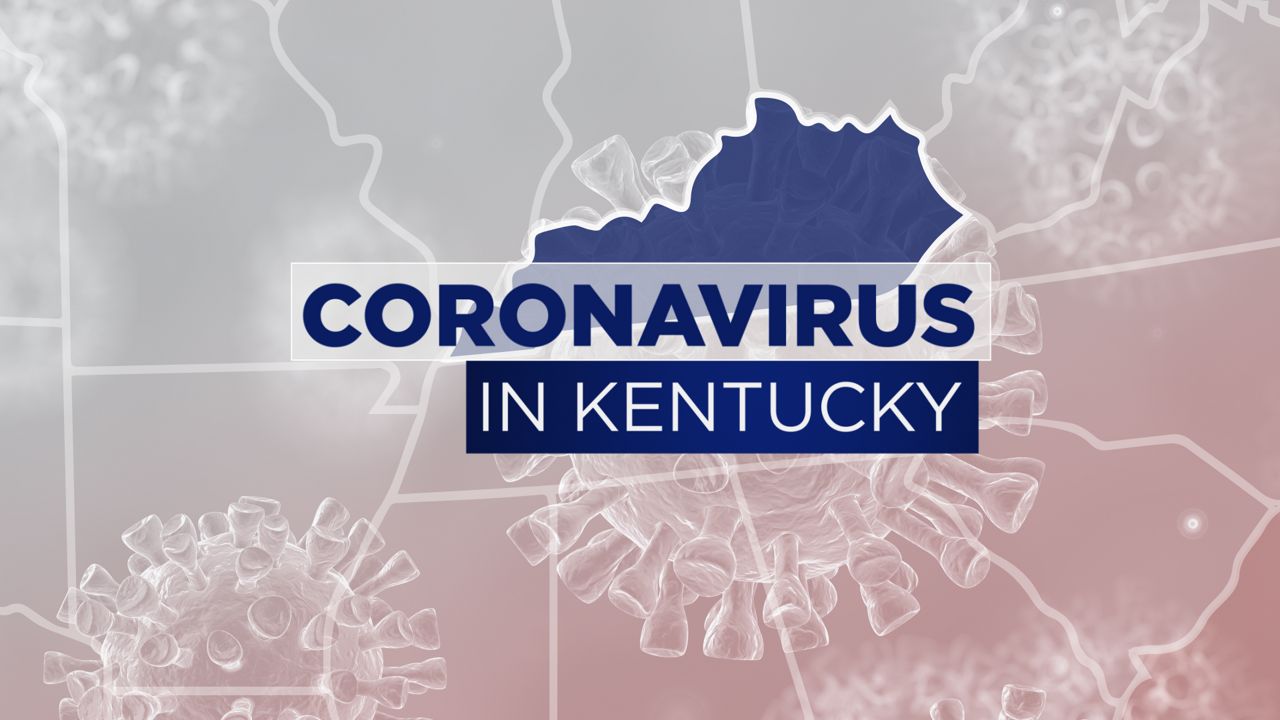This story is part of Spectrum News 1's special reporting on the coronavirus pandemic in Kentucky. Join us on-air and online Thursday, March 11 beginning at 6 a.m for special day-long coverage of A Year of COVID-19 in Kentucky.
LEXINGTON, Ky. — About a year ago, Americans started understanding the severity of what became the COVID-19 virus. Since then, the pandemic tightened its grip on people, businesses, and people’s overall way of life.
In early 2020, it was unclear if COVID-19 would become a problem in America. By March it was officially declared a pandemic by the World Health Organization, and a nationwide state of emergency was issued as the number of positive cases nearly doubled with every passing day.
It was March 22, 2020, when, for many, the reality of COVID-19 became clear after Kentucky Sen. Rand Paul (R), an outspoken critic of the virus, announced he had tested positive.
Many things have changed nationwide and in Kentucky, in the year since the pandemic began, and Spectrum News 1 KY is offering a comprehensive look back at how we have persevered, the challenges and victories that lie ahead, and what we have learned from combating the worst virus outbreak since the Spanish Flu in 1918.
This report delves into the many ways the pandemic has affected Kentuckians with regard to the spread of the virus, the response, education, society, the economy, and the development and availability of the much-anticipated vaccines. The past year has been full of historic moments, disastrous loss, and a renewed sense of people’s resilience.
HOW COVID-19 SPREAD

Health experts did warn that people age 65 and older were the most susceptible to the virus and most cases in Kentucky were within that demographic. With most Kentuckians living in rural areas, and a majority of rural residents being over age 65, cases surged in rural counties, many of which are isolated and a considerable distance away from healthcare facilities equipped to tend to COVID-19 patients.
As the virus raged on, younger people began testing positive for COVID-19, particularly after the state’s previously implemented stay-at-home order expired and places where people congregate – churches, schools, restaurants – started to reopen. Currently, Kentuckians age 20-29 comprise the most positive cases, with more than 74,000, or 18.1% of total positive cases.
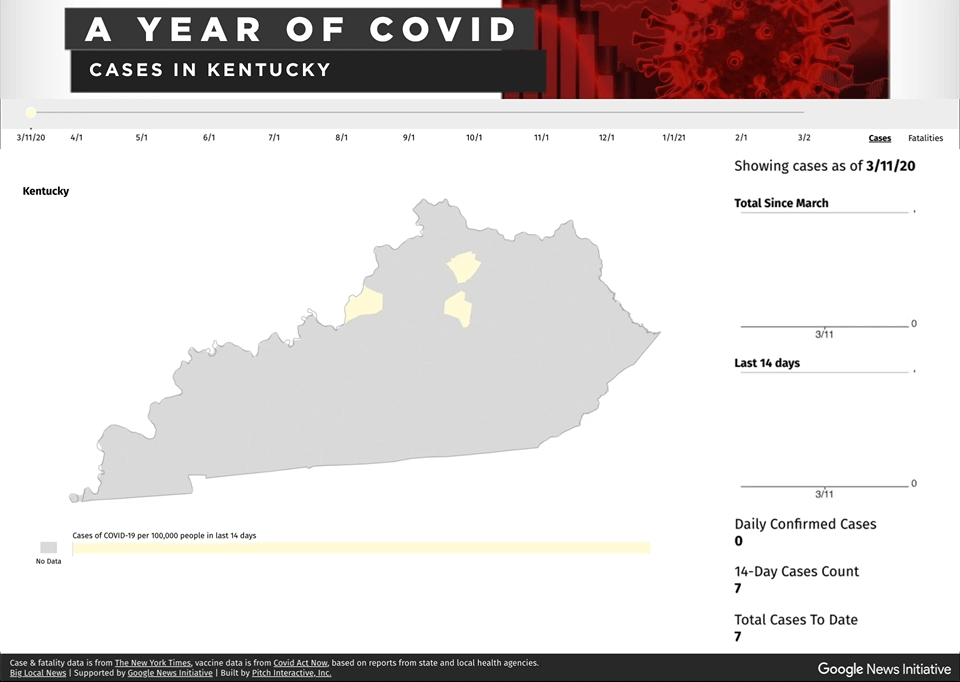
As spring turned to summer in Kentucky, infection rates continued increasing and hit a peak in late July before slightly trending downward. Cases surged in the fall, with record numbers of daily new cases being reported for several straight days mostly in Kentucky’s urban centers.
With the availability of vaccines, social distancing guidelines, capacity limitations at restaurants and other businesses, the commonwealth’s positivity rates have started to decline since the start of 2021, but policies to prevent the spread remain in place.
THE BLUEGRASS STATE’S RESPONSE
Kentucky has earned national praise for its response to the pandemic, but Beshear and state health officials have not been without critics, with several executive orders issued by the governor, and his overall power to issue them, being decided in court.
Beshear declared a state of emergency on March 6, 2020, and in the following weeks enacted a stay-at-home order that closed non-essential businesses, banned or limited household gatherings, and restricted unnecessary travel.
After Beshear extended the stay-at-home order, several Kentucky business owners, filed a lawsuit challenging the legality of the order with Kentucky Attorney General Daniel Cameron joining the suit. The Kentucky Supreme Court ultimately ruled Beshear’s order was lawful, and the state’s Republican-controlled legislature, as a result, announced plans to change state law to limit the governor’s executive power.
Beshear and state health officials have routinely faced backlash and lawsuits for declaring mask mandates, limiting indoor gatherings, and other measures – anti-mask protesters hung an effigy of Beshear outside his residence in Frankfort in May of 2020.
VACCINES
The first bit of much-needed positive news related to the pandemic came in December of 2020 when the first doses of the newly approved Pfizer vaccine arrived in Kentucky and frontline healthcare workers started getting their shots. A nurse in Queens, New York, became the first person in the nation to receive the long-awaited vaccine on Dec. 14.
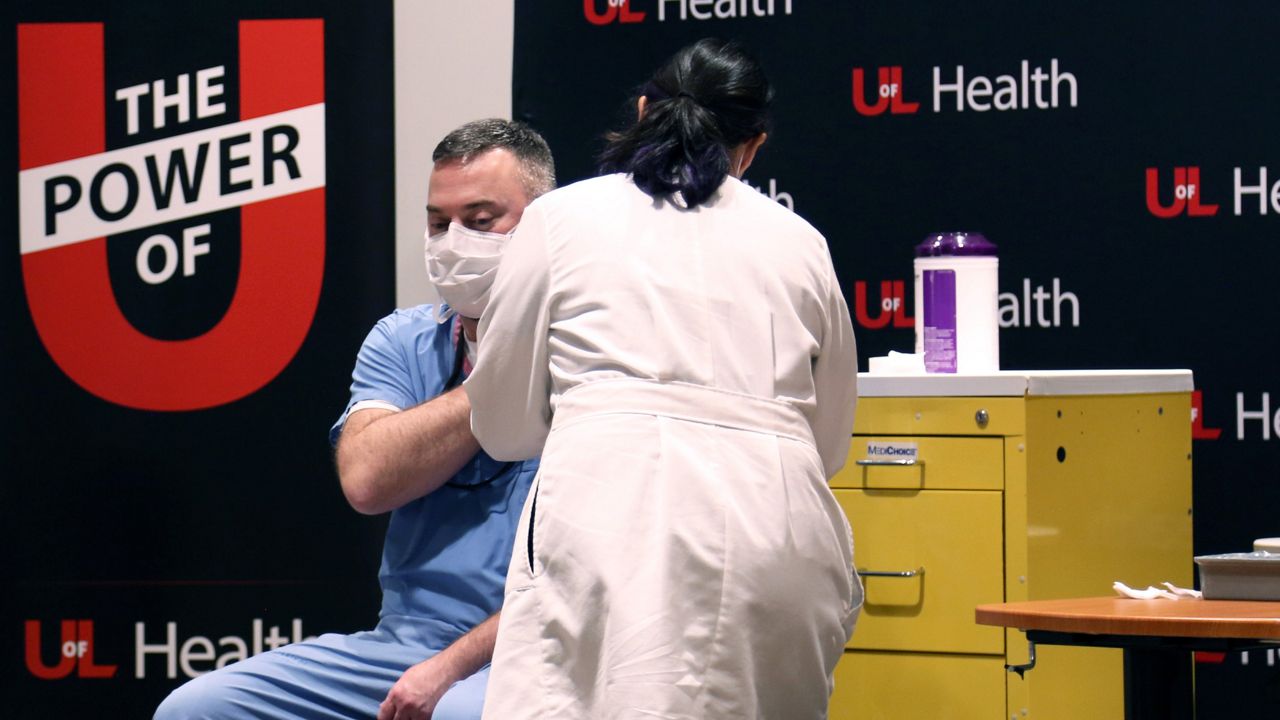
The initial vaccines were administered in Kentucky to five frontline healthcare workers at the University of Louisville Hospital around 11 a.m. on Dec. 14. Dr. Jason Smith, chief medical officer at UofL Health, was the first Kentuckian to receive the vaccine.
“Hopefully, by this time next year, this will all be behind us, and we’ll be able to be back to something more normal as far as our daily lives are concerned,” Smith said. “Our kids will be back in school, our stores and restaurants are going to be open. All of the things that we cherish in our daily lives will be back to normal, and it starts today.”
There are now three different vaccines available – from Pfizer, Moderna, and most recently Johnson & Johnson – and more than 1.1 million Kentuckians have gotten at least the first dose.
Kentucky was slow getting vaccines in people’s arms in the beginning, partly because of logistics issues in rural counties in addition to a nationwide shortage of vaccines. Booking appointments, which were mostly online, did not go as smoothly as hoped and many Kentuckians lack access to the internet.
As of March 1, Kentucky is now in phase 1C of its four-phase vaccination rollout plan and the number of people receiving doses is expected to get a boost from the addition of the availability of the Johnson & Johnson vaccine.
EDUCATION
Beshear announced on March 13, 2020, all K-12 schools would close for at least two weeks beginning March 16 and the closure was later extended multiple times before being closed for the remainder of the school year.
The closings spawned several Non-Traditional Instruction (NTI) models, including a mixture of limited in-person, all-virtual, and hybrid instruction. The beginning of the 2020 fall semester was also postponed several times until Beshear requested the year begin virtually. The school year for Fayette County Public Schools began with more than 40,000 students expected to participate in at-home learning.
“We'll continue to monitor the conditions on the ground and if we -- and this is a plea to our entire community -- we have to change our behaviors,” said the late Manny Caulk, former superintendent of Fayette County Public Schools. “We all want our children in school. In order for that to happen, we must wear our masks. We must continue to social distance, to wash our hands and use sanitizer, to make sure that we're healthy, and that those who are loved ones are healthy as well because of the actions that we're willing to take. If we could do that, and we can reduce the spread from substantial-moderate to little-to-no spread, then we'll have our children back in school. And that's what we all want, but it starts with us.”
Uncertainty, confusion, and fear related to the ongoing pandemic have changed the lives of many families – the way the parents work, the way the children are educated, and how they all spend their free time.
Children attending school at home through distance learning created a hurdle for families to navigate, as the outdoor activities that had become an escape for people in at least those two cities were abruptly halted.
Dr. Lisa King, a clinical psychologist at Bluegrass Care Navigators in Lexington, said the trauma involved with what children are experiencing creates many levels of what a child might feel is overwhelming and could therefore hamper his or her ability to cope.
“With trauma, we think of specifics, like child abuse or neglect,” King said. “But trauma is any event or events that overwhelm a person’s ability to cope. From birth to age 18, that’s a lot of different levels that might overwhelm someone. If you're an extrovert, being quarantined or being confined to your home may be very traumatic, because you get your emotional energy from being with people, so being relegated to your home may be very traumatic, and that’s when personality characteristics come into play.”
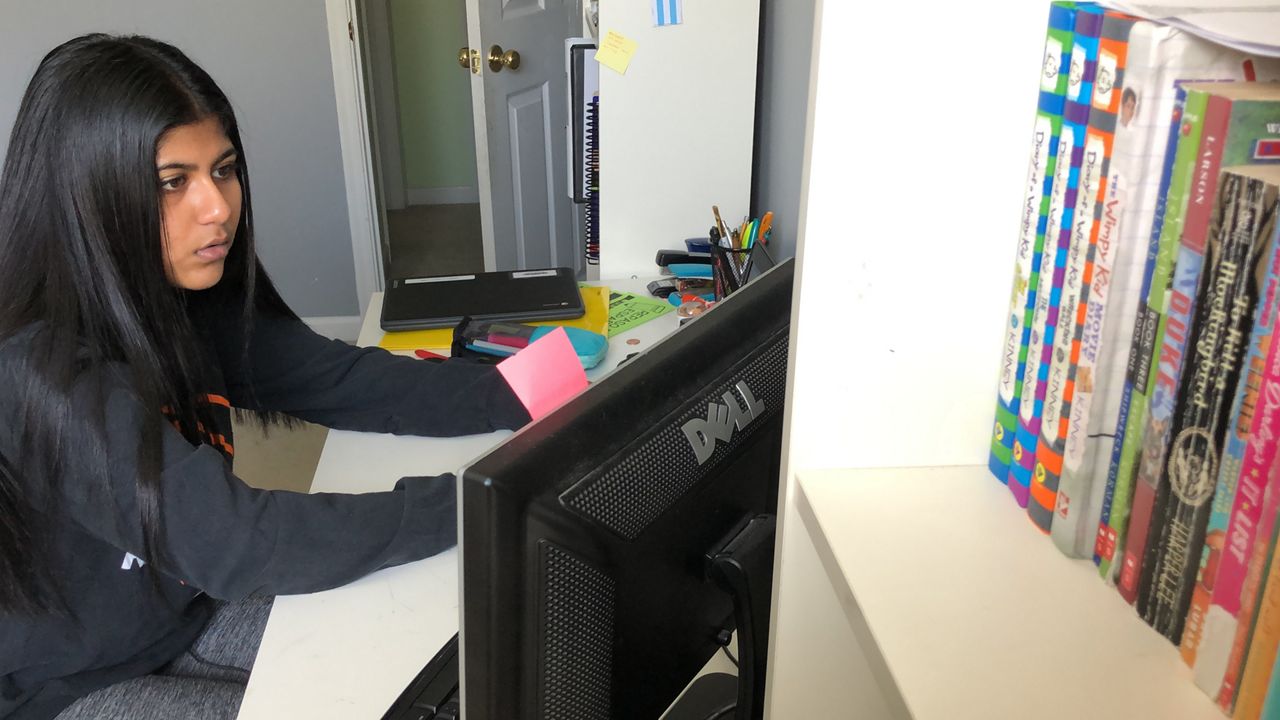
Amanda Burton, of Morehead, has two daughters that have dealt with being home in different ways. She said her 8-year-old, Sophie, has struggled with some aspects of pandemic-related shutdowns and cancellations, while her 14-year-old, Lilly, has adjusted fairly well. She said the virtual learning was an adjustment for everyone, herself included, but she has done what she can to provide some sense of normalcy for both children.
“We started a gardening project right as COVID hit,” she said. “We had never gardened before, but we did a huge gardening project over the summer and that helped a lot because they were home and they wanted to check on their plants. It kind of gave them something to look forward to every day.”
Higher education has also been adversely affected. Several Kentucky universities saw outbreaks of COVID-19 after the fall semester began, which forced thousands of students into quarantine, decreased enrollment, and loss of revenue.
SOCIAL IMPACT
Interaction with anyone outside one’s household has been scarce during the pandemic due to the danger of simply sharing the same air. As a result, Kentuckians turned to Zoom to connect by attending weddings, graduations, birthday parties, and most other social gatherings. Socially distanced and virtual get-togethers have still taken their toll on people’s mental health, as a Kaiser Family Foundation study shows 40% of adults in America reported symptoms of anxiety or depression with young adults and people of color experiencing the most strain.
Many parents have not been able to return to work either because of pandemic shutdowns, their children’s distance learning at home, or both. Some parents are more socially isolated than they were before the pandemic because staying home and taking care of a child already separates them from everyone else.
“Many parents have removed themselves even further by doing doctor’s visits virtually and things that you would normally get out to do they are doing from home, so parents are more socially isolated, which increases their stress,” King said. “We, as an agency, are trying to address that, but just by talking to colleagues who work with kids and families, they're seeing a lot more anxiety and a lot more depression, both in children and adults.”
The pandemic has also highlighted racial and political divides in healthcare. A Kaiser Family Foundation (KFF) study shows about a quarter (27%) of the public remains vaccine-hesitant, saying they probably or definitely will not get a COVID-19 vaccine even if it were available for free and deemed safe by scientists. Vaccine hesitancy is highest among Republicans (42%), people ages 30-49 (36%), and rural residents (35%) – those three groups represent a substantial portion of Kentuckians.
Thirty-five percent of Black adults, a group the KFF study shows has “borne a disproportionate burden of the pandemic,” said they definitely or probably will not get vaccinated, as do one-third of those that said they have been deemed essential workers and 3-in-10 (29%) of those who work in a healthcare delivery setting.
Scientists and public health officials have also battled a considerable amount of misinformation during the pandemic as conspiracy theories about the virus and the vaccine have been mainstays online and often led people to put themselves and others in danger.
Vince Venditto, Ph.D., assistant professor in the University of Kentucky College of Pharmacy’s Department of Pharmaceutical Science has extensive expertise in vaccine design and went to great lengths to debunk the more common myths about the vaccine.
“We are seeing a concentration of vaccine hesitancy because everybody in the world needs to be vaccinated right now,” he said. “We’re seeing a lot of stories that are popping up about all of these myths, about it being rushed out and we don't know what's in it. I know that there's this constant underlying hesitancy about vaccines, but because every single person in the world needs one, I think a lot of this stuff is coming to the surface and we're seeing it more.”
ECONOMIC IMPACT
The pandemic’s effect on the economy in Kentucky has been extreme. As COVID-19 cases kept climbing, postponements and cancellations continued. The Kentucky Derby, the first leg of the Triple Crown, was postponed until September, marking the first time in 75 years the race would not take place on the first Saturday in May. Even in September, it took place without spectators.
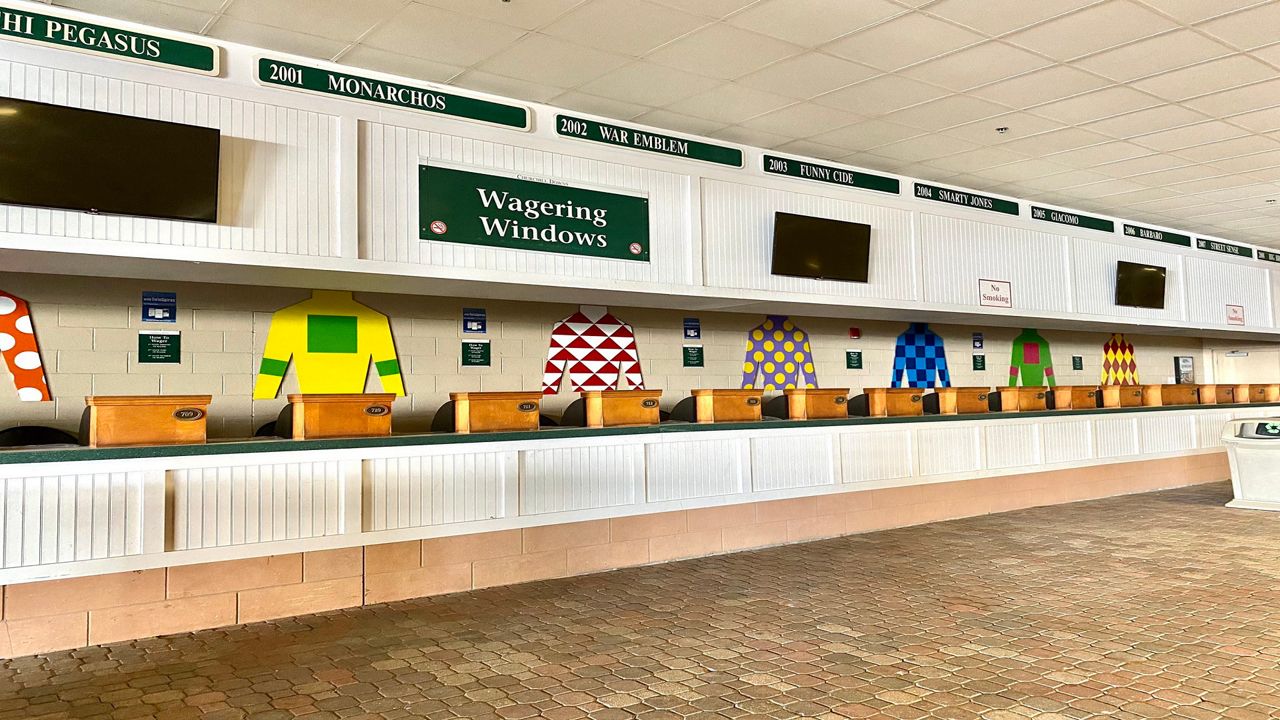
Overall, Kentucky has suffered an economic downturn not experienced since the Great Depression. Businesses that rely on crowds of people, such as food service, arts and entertainment, and hospitality, have been hit especially hard.
The Kentucky Travel Industry Association (KTIA) is a trade group that represents businesses in the travel and tourism industry, including hotels. KTIA President and CEO Hank Phillips said the state’s hotels started suffering financially in February.
“Hotels in Kentucky and nationally have, to a large extent, been devastated by virtue of the drop off and in travel,” Phillips said. “They never had to close, like restaurants, bars, and other places, although hotels that have restaurants and bars, they had to close those and adhere to the same rules as a free-standing restaurant. They have been feeling this pain just as the overall industry.”
The hotel segment is facing a historic number of delinquencies and is the most heavily hit sector of the commercial mortgage-backed securities (CMBS) market, according to the report. Nearly 4,000 hotel industry leaders sent an urgent letter to Congress asking for immediate action to help hotels avoid foreclosure and the loss of tens of thousands of jobs.
“Hotels were among the first to feel the pain, among those most deeply affected and will take the longest to rebound,” Phillips said. “Not just hotels, but the travel and tourism industry overall.”
Many restaurant owners in Kentucky were worried about closing permanently.
“Leisure and Hospitality Industry has counted for over 20 percent jobs loss in Kentucky,” said Edward Lee, the James Beard Award-winning chef with two restaurants in Louisville in July of 2020. “As a restaurateur and someone who had seen my personal revenue drop by over 75%, right now we’re looking at basically having more debt and more loans is not going to solve the question or my restaurant inevitably closing in the next few months.”
Unemployment claims surged throughout the pandemic, and technical issues and a backlog of filers left many jobless Kentuckians waiting weeks for relief.
Innovation may be the key to the economy rebounding in Kentucky, however, as startups have opened at record numbers, business owners adapt to new ways of shopping and even distilleries bottling hand sanitizer alongside bourbon.
THE FUTURE
With vaccinations ramping up, case counts on the decline, and warmer weather on the horizon, things seem to be looking up for the commonwealth. There are 567 vaccination sites in Kentucky as cases continue declining.
“This means that vaccine locations are getting closer and closer to you. This is the infrastructure we have to build,” Beshear said. “The president told us earlier this week that every American adult who wants a shot can get their shot of hope by the end of May. That means that if we can get everybody interested, we’re going to vaccinate another 2.5 million people in the next three months.”
Preventive measures will likely be encouraged into the near future, but a potential finish line in sight should be a relief to most Kentuckians.



